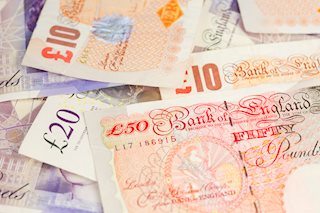
GBP/USD weakens to near 1.2895 in Friday’s early Asian session.
The US Nonfarm Payrolls data will take center stage later on Friday.
The UK Autumn Forecast Statement weighs on the GBP.
The GBP/USD pair remains on the defensive around 1.2895, the lowest since August 16 during the early Asian trading hours on Friday. The major pair edges lower after the UK Labour government announced its first Autumn Forecast Statement on Wednesday.
The US inflation, as measured by the Personal Consumption Expenditure Price Index (PCE), grew at a slightly faster-than-expected pace in September. Data released by the US Bureau of Economic Analysis (BEA) on Thursday showed that the headline PCE rose 2.1% YoY in September, compared to 2.2% in August, in line with the market consensus of 2.1%.
The core PCE, which excludes volatile food and energy prices, jumped 2.7% in the same period, matching August's rise and above the market estimation of 2.6%. According to the CME FedWatch tool, the financial markets expect the Fed to cut the interest rate by 25 basis points (bps) in both of the policy meetings to be held in the November and December meetings.
Investors will closely monitor the US Nonfarm Payrolls (NFP) data for October on Friday for fresh impetus. The NFP report is expected to show that the US economy added 113K job additions in October, while the Unemployment Rate is expected to remain steady at 4.1%.
On the UK’s front, the UK's new Labour government released its first budget on Wednesday, which includes £40 billion in tax rises to plug a hole in the public finances and allow for investment in public services.
Additionally, the UK’s Office for Business Responsibility (OCR) upwardly revised inflation forecasts for 2024 to 2.5% from 2.2% estimated earlier in March, a revision that also led traders to expect less interest rate reductions by the Bank of England (BoE). This, in turn, might cap the downside for the Pound Sterling (GBP).
Pound Sterling FAQs
The Pound Sterling (GBP) is the oldest currency in the world (886 AD) and the official currency of the United Kingdom. It is the fourth most traded unit for foreign exchange (FX) in the world, accounting for 12% of all transactions, averaging $630 billion a day, according to 2022 data. Its key trading pairs are GBP/USD, also known as ‘Cable’, which accounts for 11% of FX, GBP/JPY, or the ‘Dragon’ as it is known by traders (3%), and EUR/GBP (2%). The Pound Sterling is issued by the Bank of England (BoE).
The single most important factor influencing the value of the Pound Sterling is monetary policy decided by the Bank of England. The BoE bases its decisions on whether it has achieved its primary goal of “price stability” – a steady inflation rate of around 2%. Its primary tool for achieving this is the adjustment of interest rates. When inflation is too high, the BoE will try to rein it in by raising interest rates, making it more expensive for people and businesses to access credit. This is generally positive for GBP, as higher interest rates make the UK a more attractive place for global investors to park their money. When inflation falls too low it is a sign economic growth is slowing. In this scenario, the BoE will consider lowering interest rates to cheapen credit so businesses will borrow more to invest in growth-generating projects.
Data releases gauge the health of the economy and can impact the value of the Pound Sterling. Indicators such as GDP, Manufacturing and Services PMIs, and employment can all influence the direction of the GBP. A strong economy is good for Sterling. Not only does it attract more foreign investment but it may encourage the BoE to put up interest rates, which will directly strengthen GBP. Otherwise, if economic data is weak, the Pound Sterling is likely to fall.
Another significant data release for the Pound Sterling is the Trade Balance. This indicator measures the difference between what a country earns from its exports and what it spends on imports over a given period. If a country produces highly sought-after exports, its currency will benefit purely from the extra demand created from foreign buyers seeking to purchase these goods. Therefore, a positive net Trade Balance strengthens a currency and vice versa for a negative balance.
* The content presented above, whether from a third party or not, is considered as general advice only. This article should not be construed as containing investment advice, investment recommendations, an offer of or solicitation for any transactions in financial instruments.

